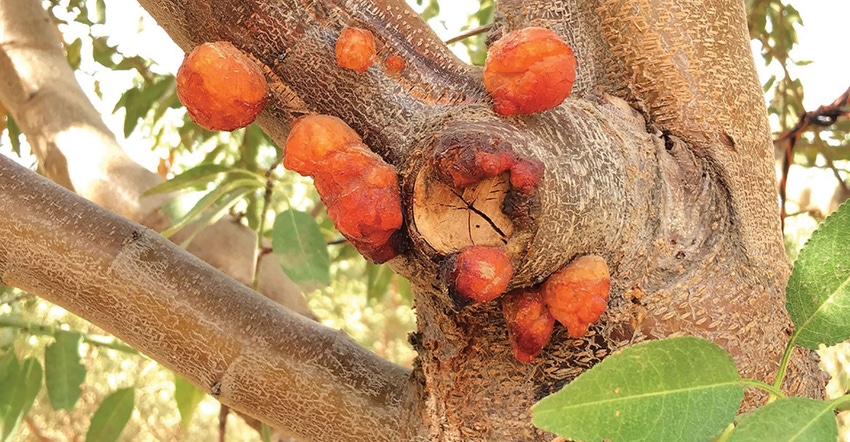
One of the many annual season chores on the To-Do List involves sharpening of tools to do re-shaping during the dormant portion of the growing season, from formation pruning of younger trees to production pruning (thinning or heading) of older tree canopies.
The skills of a surgeon are put into play here as sloppy pruning in orchard systems can cause cankers to originate around pruning wounds. In almonds, canker pathogens infect trees mainly through improper pruning where wounds are made at primary and secondary scaffold sections that become entry points for the canker-causing pathogens.
“Fungal canker diseases have become an increasing concern to California growers as they are affecting a greater extent of young trees resulting in branch dieback and tree death in almond orchards,” says University of California, Davis plant pathologist Florent Trouillas.
Cankers are lesions on stems, twigs, or branches with dead areas that block hydration and nutrient transport to the tree, causing die back. Cankers are generally caused by fungi that invade bark tissue and current season’s wood. If they colonize in internal wood tissue, canker rot can persist for years.
“Microorganisms that usually don’t cause disease in non-stressed hosts may become opportunistic pathogens in plants undergoing stress of some kind, drought, sudden temperature fluctuations, or a change in production practices,” Trouillas said. “Cankers mostly originate from pruning wounds on limbs and trunks as well as from cracks formed at the junction of scaffold branches, downward toward the graft union or upward into scaffold branches.”
Amber-colored gum that exudes around the cracks will turn color, changing to a darker reddish brown.
One of the most prevalent canker diseases in California almonds is associated with shaker damage, trunks injured during harvest. Ceratocystis canker also shows up in fresh pruning wounds, spread by sap-feeding beetles and fruit flies.
Bacterial canker (Pseudomonas syringae) survives on plant surfaces and is spread by splashing rain along with springtime temperatures. Nitrogen-deficient trees are most prone to bacterial canker as are younger trees in the 2-to-8-year-old range.
Gumballs around the canker
Amber-colored gumballs around the margin of the canker indicate the presence of the cankers which are perennial and hang around for several years. Another unwanted player over the last decade is a band canker that produces oozing amber sap-formed rings around the circumference of the tree, particularly those receiving aggressive water and nitrogen inputs.
“Band canker and Botryosphaerlaceae fungal infections are particularly common in young almond orchards in both the Sacramento and northern San Joaquin Valleys,” according to Cooperative Extension specialist Trouillas.
One commonly adopted practice for the management of fungal canker diseases in almonds is rapid care of fresh pruning wounds.
“Our research indicates both Topsin M (Thiorphanate-methyl, FRAC 1) and Vintec (Trichoderma atroviride SCA) can provide great protection of almond pruning wounds against a broad spectrum of fungal canker pathogens including those responsible for Botryosphaeriaceae cankers (band canker), Ceratocystis canker as well as both Cytospora and Eutypa canker.
“Recently Topsin M has received a 2(ee) label recommendation for use in almond as a pruning wound protectant against canker pathogens. The biological control product Vintec is currently in the registration phase in California for use against canker diseases of almond.”
Further information is at the University of California Integrated Pest Management website. Information is also available here.
For more news on tree nuts as reported by growers and farm advisors, subscribe to the Tree Nut Farm Press e-newsletter.
About the Author(s)
You May Also Like




